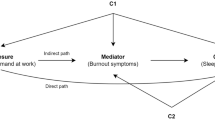Abstract
Background
Insomnia and burnout have been suggested to form a bidirectional association.
Purpose
The aim of this study was to investigate whether there is a bidirectional relationship between insomnia and burnout over the course of a year among individuals in the workforce.
Method
This study employed a prospective design, where a randomly selected sample from the general population (20–60 year; N = 1,812) filled out a survey on insomnia and burnout. In employed participants (n = 1,258), the associations between insomnia and three dimensions of burnout (Maslach Burnout Inventory–General Survey) were examined while controlling for age, gender, anxiety, and depression.
Results
The bivariate correlations between insomnia and the three burnout dimensions were significant at a low level (η 0.12–0.29). The longitudinal analyses demonstrated that insomnia was not associated with the incidence of burnout and vice versa. However, insomnia was demonstrated to increase the risk for the persistence of emotional exhaustion (OR = 3.02). Further, insomnia was not associated with the persistence of professional efficacy and cynicism, and burnout was not related to the persistence of insomnia.
Conclusion
In summary, this investigation demonstrated that insomnia and burnout are not bidirectionally related in the working population. While insomnia was linked to the maintenance of the central part of burnout, burnout was not related to future insomnia.
Similar content being viewed by others
References
Weber A, Jaekel-Reinhard A. Burnout syndrome: a disease of modern societies? Occup Med. 2000;50:512–7.
Maslach C, Leiter MP. The truth about burnout: how organizations cause personal stress and what to do about it. San Francisco: Jossey-Bass; 1997.
Melamed S, Kushnir T, Shirom A. Burnout and risk factors for cardiovascular diseases. Behav Med. 1992;18:53–60.
Shirom A. Burnout in work organizations. In: Cooper CL, Robertson I, editors. International review of industrial and organizational psychology. New York: Wiley; 1989. p. 25–48.
Schaufeli WB, Enzmann D. The burnout companion to study and practice: a critical analysis. London: Taylor & Francis; 1998.
Söderström M, Ekstedt M, Åkerstedt T, Nilsson J, Axelsson J. Sleep and sleepiness in young individuals with high burnout scores. Sleep. 2004;27:1369–77.
Ekstedt M, Söderstrom M, Åkerstedt T, Nilsson T, Sondergaard HP, Aleksander P. Disturbed sleep and fatigue in occupational burnout. Scand J Work Environ Health. 2006;32:121–31.
Grossi G, Perski A, Evengård B, Blomkvist V, Orth-Gomér K. Physiological correlates of burnout among women. J Psychosom Res. 2003;55:309–16.
Melamed S, Ugarten U, Shirom A, Kahana L, Lerman Y, Froom P. Chronic burnout, somatic arousal and elevated salivary cortisol levels. J Psychosom Res. 1999;46:591–8.
Bell RB, Davison M, Sefcik D. A first survey: measuring burnout in emergency medicine physician assistants. J Am Acad Physician Assist. 2002;15:40–55.
Peterson U, Demerouti E, Bergström G, Samuelsson M, Ake MA, Nygren Å. Burnout and physical and mental health among Swedish healthcare workers. J Adv Nurs. 2008;62:84–95.
Vela-Bueno A, Moreno-Jimenez B, Rodriguez-Munoz A, Olavarrieta-Bernardino S, Fernandez-Mendoza J, De la Cruz-Troca JJ, et al. Insomnia and sleep quality among primary care physicians with low and high burnout levels. J Psychosom Res. 2008;64:435–42.
Armon G, Shirom A, Shapira I, Melamed S. On the nature of burnout–insomnia relationships: a prospective study of employed adults. J Psychosom Res. 2008;65:5–12.
Lindblom K, Linton SJ, Fedeli C, Bryngelsson IL. Burnout in the working population: relations to psychosocial work factors. Int J Behav Med. 2006;13:51–9.
Partinen M, Gislason T. Basic Nordic Sleep Questionnaire (BNSQ): a quantitated measure of health and dysfunction. J Sleep Res. 1995;4:150–5.
Broman JE, Lundh LG, Hetta J. Insufficient sleep in the general population. Neurophysiol Clin. 1996;26:30–9.
Liljenberg B, Almqvist M, Hetta J, Roos BE, Ågren H. The prevalence of insomnia: the importance of operationally defined criteria. Ann Clin Res. 1988;20:393–8.
Linton SJ, Bryngelsson IL. Insomnia and its relationship to work and health in a working-age population. J Occup Rehabil. 2000;10:169–83.
American Psychiatric Association. Diagnostic and statistical manual of mental disorders. 4th ed. Washington: American Psychiatric Association; 1994.
American Sleep Disorders Association. International classification of sleep disorders, revised: diagnostic and coding manuals. Rochester: American Sleep Disorders Association; 1997.
Maslach C, Jackson SE, Leiter MP. Maslach Burnout Inventory Manual. 3rd ed. Palo Alto: Consulting Psychologists Press; 1996.
Leiter MP, Maslach C. Preventing burnout and building engagement: a complete program for organizational renewal. San Francisco: Jossey-Bass; 2000.
Leiter MP, Schaufeli WB. Consistency of the burnout construct across occupations. Anxiety Stress Coping. 1996;9:229–43.
Taris TW, Schreurs PJG, Schaufeli WB. Construct validity of the Maslach Burnout Inventory—General Survey: a two-sample examination of its factor structure and correlates. Work Stress. 1999;13:223–37.
Roelofs J, Verbraak M, Keijsers GPJ, de Bruin MBN, Schmidt AJM. Psychometric properties of a Dutch version of the Maslach Burnout Inventory General Survey (MBI-DV) in individuals with and without clinical burnout. Stress Health. 2005;21:17–25.
Herrmann C. International experiences with the Hospital Anxiety and Depression Scale—a review of validation data and clinical results. J Psychosom Res. 1997;42:17–41.
Zigmond AS, Snaith RP. The hospital anxiety and depression scale. Acta Psychiatr Scand. 1983;67:361–70.
Acknowledgments
We would like to express our appreciation to the Department of Occupational and Environmental Medicine at Örebro University Hospital for financial support.
Author information
Authors and Affiliations
Corresponding author
Rights and permissions
About this article
Cite this article
Jansson-Fröjmark, M., Lindblom, K. Is There a Bidirectional Link Between Insomnia and Burnout? A Prospective Study in the Swedish Workforce. Int.J. Behav. Med. 17, 306–313 (2010). https://doi.org/10.1007/s12529-010-9107-8
Published:
Issue Date:
DOI: https://doi.org/10.1007/s12529-010-9107-8



